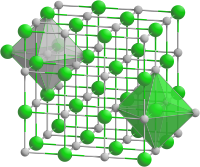
| |
| Names | |
|---|---|
| Other names
Dysprosium monophosphide, phosphanylidynedysprosium
| |
| Identifiers | |
3D model (JSmol)
|
|
| EC Number |
|
PubChem CID
|
|
CompTox Dashboard (EPA)
|
|
| |
| |
| Properties | |
| DyP | |
| Molar mass | 193.474 |
| Appearance | Crystals |
| Density | 7.06 g/cm3 |
| Structure | |
| Cubic | |
| Hazards | |
| GHS labelling: | |

| |
| Warning | |
| H315, H319, H335 | |
| P261, P280, P304, P305, P338, P340, P351, P405, P501 | |
| Related compounds | |
Other anions
|
Dysprosium nitride Dysprosium arsenide Dysprosium antimonide Dysprosium bismuthide |
Other cations
|
Terbium phosphide Holmium phosphide |
Except where otherwise noted, data are given for materials in their standard state (at 25 °C [77 °F], 100 kPa).
| |
Dysprosium phosphide is an inorganic compound of dysprosium and phosphorus with the chemical formula DyP.[1][2][3]
Synthesis
The compound can be obtained by the reaction of phosphorus and dysprosium at high temperature.
- 4 Dy + P4 → 4 DyP
Physical properties
DyP has a NaCl structure (a=5.653 Å),[4] where dysprosium is +3 valence. Its band gap is 1.15 eV, and the Hall mobility (μH) is 8.5 cm3/V·s.[5]
DyP forms crystals of a cubic system, space group Fm3m.[6]
Uses
The compound is a semiconductor used in high power, high frequency applications and in laser diodes.[1][7]
References
- ^ a b "Dysprosium Phosphide". American Elements. Retrieved 5 January 2022.
- ^ Ganjali, Mohammad Reza; Gupta, Vinod Kumar; Faridbod, Farnoush; Norouzi, Parviz (25 February 2016). Lanthanides Series Determination by Various Analytical Methods. Elsevier. p. 49. ISBN 978-0-12-420095-1. Retrieved 5 January 2022.
- ^ Terahertz and Gigahertz Photonics. SPIE. 1999. p. 217. ISBN 978-0-8194-3281-0. Retrieved 5 January 2022.
- ^ Busch, G.; Junod, P.; Vogt, O.; Hulliger, F. (15 August 1963). "Ferro- and metamagnetism of rare earth compounds". Physics Letters. 6 (1): 79–80. Bibcode:1963PhL.....6...79B. doi:10.1016/0031-9163(63)90228-2. Retrieved 5 January 2022.
- ^ Ren, Yufang; Meng, Jian (1988). "On the Optical and Electrical Properties of Dysprosium and Ytterbium Monophosphides". Chinese Journal of Applied Chemistry (in Chinese). 5 (3): 39–42. Retrieved 5 January 2022.
- ^ "Dysprosium Phosphide DyP". materialsproject.org. Retrieved 24 December 2021.
- ^ "Dysprosium - an overview | ScienceDirect Topics". sciencedirect.com. Retrieved 5 January 2022.
